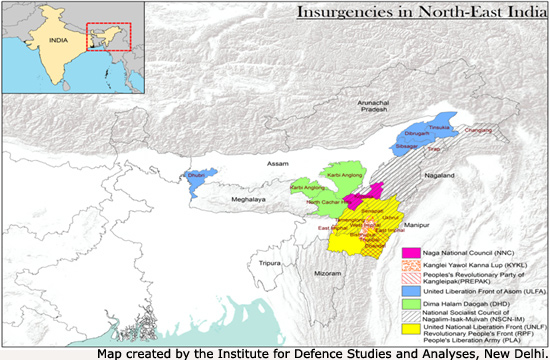Militarism and the Future of Democracy in Manipur: Impressions from the Field
While most of the states in Northeast India are slowly but steadily edging towards the resolution of the multiple armed conflicts that have plagued them for decades, Manipur continues to remain unstable. In Assam, the dialogue process is underway with the United Liberation Front of Asom (ULFA). In Nagaland, peace talks between the Union Government and the National Socialist Council of Nagalim–Isak-Muivah (NSCN-IM) have witnessed significant progress in recent months. In Manipur, on the other hand, while Suspension of Operations (SoO) have been signed with the Kuki armed groups, the Meitei armed groups like the United National Liberation Front of Manipur (UNLF), the Revolutionary People’s Front (RPF) and its armed wing the People’s Liberation Army (PLA), the People’s Revolutionary Party of Kangleipak (PREPAK) and the Kanglei Yawol Kanna Lup (KYKL) have not signed any ceasefire or SoO with the Union government and continue to operate with impunity in the state. Added to this is the Naga-Meitei divide, with the NSCN-IM staking claim over 90 per cent of the state’s territory.

Against this backdrop a national seminar was held in Manipur University in March 2011. Different stakeholders including local policymakers, civil society actors, security forces personnel, journalists and academics provided their perspectives on the conflict in the state. Critical issues were discussed in detail including Manipur’s history, the Indian state’s national security discourse and its rationale, growing militarism and the impact of violence on society and especially on women, ideological issues, counter-insurgency and the politics of development, and the challenging task of upholding democratic norms and institutions.
Six critical propositions that merit serious attention from the policy perspective can be identified based on the seminar’s proceedings and the author’s field experience in Manipur. First, there is the compression of democratic space in Manipur due to the existence of multiple armed groups as well as the presence of a large counter-insurgency force. Second, ‘ethnic assertion’ limits the space for inclusive democratic politics. Third, the overwhelming feeling of ‘under-representation’ in national policy making structures adversely impacts the local perceptions of India. Fourth, people genuinely believe that the Union government is interfering in almost all local issues. Fifth, the absence of efficient local state structures creates a ‘fearful psyche’ with regard to physical wellbeing among the people of the state. Sixth, central development schemes are viewed as counter-insurgency measures instead of being viewed as efforts by the Indian state to meaningfully uplift the local people.
The overall tenor of discussions in the seminar, which was dominated by voices representing the Meitei community and to a lesser extent the Naga community, indicated a number of policy options that merit consideration.
First, it emerged that there was an urgent need for a balanced discourse on the issue of militarism in Manipur. Most speakers argued that the growing militarism was due to a psychologically oriented ‘mindset of militarism’ fuelled by the visible presence of the security forces personnel and non-state armed groups in such large numbers among the civil society. This leaves a deep seated negative impression on the minds of the younger generations, thereby blocking out values that are intrinsic to democracy like inclusiveness, pluralism, individual rights, and the impression of a public welfare oriented state.
Second, there exists an ideational gap between the ‘idea of India’ as a pluralistic, multi-cultural, multi-ethnic, inclusive and vibrant democratic entity and the perception of the actual behaviour of the Indian state in conflict prone states like Manipur. Therefore, while there is expressed hope in the idea of a democratic India as envisioned by Gandhi and Nehru, there is need for a concerted effort to bridge the democracy deficit.
Third, ethnic communities in Manipur should reconsider their own perception of ‘victimisation’, which was described by a local scholar as the “psyche of a defeated people”. Hence, while political discourses within Manipur tend to be located within two overarching conceptual parameters, British India and post-colonial India, where Manipur is portrayed as a victim of discrimination, little serious effort has been made by local actors to construct an elegant rational discourse on how to create a pluralistic, multi-ethnic and democratic Manipur. Once this new inclusive discourse is crafted, even the Naga discourse of so-called historical ethnic exclusivity will appear self-defeating and non-progressive.
Fourth, centre-state relations and democratic norms were the central focus in local discourses. A lot of political anxiety was noticeable with regard to the presence of military personnel in the state, lack of a responsible government, and the state’s inability to gain monopoly over organised violence. People wish to move beyond the narrow prism of armed groups and armed conflict to a non-violent public sphere.
Fifth, local political communities argue that the political destiny of the people of Manipur is decided by national elites with little input from local elites. A larger visible presence of able local politicians and public intellectuals in the national decision making process and representative structures will help to assuage these grievances.
A central message that emerged from the seminar was that while the two core national security objectives of India, territorial integrity and sovereignty, stand the country in good stead, individual progress and overall societal happiness, especially of its ethnic minorities, would help achieve these objectives. Therefore, local grievances and the perception in Manipur of India as a mechanical bureaucratic state should not be taken lightly. It is critical that continuing extortions, intimidatory tactics and kidnapping by the armed groups in the state be controlled through strict law enforcement measures. There is also an urgent need for greater democratic outreach with the local population which is living in a militarised zone, by putting in place responsive, accountable and humane state structures.




